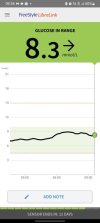Hi all.
I have a question. I suspect that my basal may be low for my needs but I wanted to ask what you all thought. I've observed a trend where my bgs will go down at some point in the night but then start to rise as i wake and continue to rise. I know I have the dawn effect and always have but I'm wondering how one knows whether it's that or the basal being low. Take a look at my graphs from when I woke a little before 6am. The dip in the morning is from a short walk but I'm still within the range of 8. I haven't had breakfast yet and so no bolus and are only due for my basal in another hour plus. Any thoughts would be highly appreciated.
I have a question. I suspect that my basal may be low for my needs but I wanted to ask what you all thought. I've observed a trend where my bgs will go down at some point in the night but then start to rise as i wake and continue to rise. I know I have the dawn effect and always have but I'm wondering how one knows whether it's that or the basal being low. Take a look at my graphs from when I woke a little before 6am. The dip in the morning is from a short walk but I'm still within the range of 8. I haven't had breakfast yet and so no bolus and are only due for my basal in another hour plus. Any thoughts would be highly appreciated.




